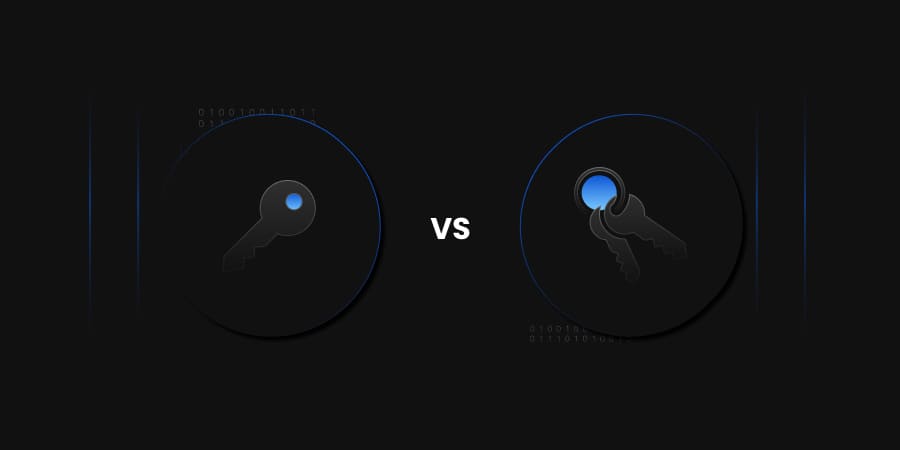Introduction
In today’s world, most of the applications and services we use are connected with each other in some way. This connection is made possible through Application Programming Interfaces (APIs), which allow different systems to share data and work together smoothly. From banking apps and social media platforms to cloud services and e-commerce websites, APIs are everywhere. As APIs become more widely used, the risks around them are also increasing. According to Akamai’s 2024 State of the Internet (SOTI) report, there were 311 billion web attacks in 2024, a 33% year-over-year increase. Notably, 150 billion of these attacks targeted APIs, highlighting the growing risks they face and the urgent need for comprehensive API security.
What is API Security?
An API is a set of rules and protocols that enables software applications to communicate with each other. It defines how requests are made, how data is exchanged, and how responses are structured, allowing systems to work together in a standardized way. APIs power a wide range of technologies, making them a fundamental building block of modern software architecture.
However, the same connectivity that makes APIs powerful also makes them vulnerable. REST APIs remain the industry standard, and emerging technologies like GraphQL (Graph Query Language), gRPC (Google Remote Procedure Call), and WebSockets are transforming data exchange. GraphQL offers precise data retrieval, gRPC improves performance with protocol buffers and streaming, and WebSockets enable real-time communication. APIs often expose critical functions and exchange sensitive information, making them a prime target for attackers. This creates a strong need to secure them in order to protect data, ensure reliable services, and maintain user trust.
API security refers to the practice of protecting APIs from unauthorized access, misuse, data breaches, and other malicious activities. Since APIs act as entry points into applications and business systems, an insecure design or implementation can quickly turn them into the weakest link in an organization’s overall security posture.
Risks Posed Due to Lack of API Security
The need to secure APIs can be understood by looking at the different risks they pose:
- Exposure of Sensitive Data: APIs often exchange highly valuable information such as personally identifiable information (PII), financial details, healthcare records, or confidential enterprise data. If APIs return more information than required, lack encryption, or fail to mask sensitive fields, attackers can easily exploit them to steal data. Beyond direct theft, exposed data can also be aggregated with other breached datasets, increasing the overall risk of identity fraud and profiling.
- Direct Entry Point for Attackers: APIs provide direct access to application logic and sensitive data, which makes them a prime focus for adversaries. Weak authentication or authorization mechanisms can enable attackers to impersonate users, escalate privileges, or exploit functions not intended for exposure. In recent years, many large-scale breaches have occurred because attackers discovered hidden API endpoints or manipulated parameters to gain unauthorized access. Tools like APIsec and Salt Security have also revealed how easily unmonitored APIs can expose hidden endpoints to attackers.
- Business Disruption: A single compromised API can disrupt critical services, leading to downtime, operational chaos, and financial loss. For example, attackers may exploit APIs for denial-of-service (DoS) attacks, overwhelming systems with traffic. In industries like banking, healthcare, or retail, even a short disruption caused by an insecure API can translate to lost revenue, customer dissatisfaction, and long-term reputational harm. API incidents also require incident response, investigation, and remediation efforts, diverting resources from innovation to damage control.
- Compliance and Regulatory Pressure: Laws such as GDPR, HIPAA, and PCI DSS impose strict requirements on data handling, storage, and protection. Since APIs frequently transport sensitive information across systems, any failure to secure them can result in compliance violations, fines, and legal liabilities. Furthermore, regulators are becoming increasingly aware of API-related risks, meaning organizations cannot afford to overlook them. Compliance is not just a legal checkbox; it reinforces customer trust and demonstrates a proactive commitment to security.
Recent industry research also highlights the scale of risks when APIs are left unsecured. According to FireTail’s 2024 report, API data breaches rose by 80% year-over-year, with the number of records exposed growing by 214%, amounting to nearly 175 million records in 2023 alone. Since 2017, over 1.6 billion records have been compromised through API-related incidents.
In the latest OWASP API Security Top 10 list (2023), Broken Object Level Authorization (BOLA) holds the top position as API1:2023. It occurs when an API fails to properly verify a user’s access to a specific object or resource, allowing attackers to manipulate object IDs or parameters to access data that isn’t theirs. BOLA is among the most frequently exploited API flaws and highlights the importance of enforcing strong authorization and access control at every endpoint.
In fact, the 2025 API Security Report by Traceable found that 57% of organizations experienced at least one API-related breach in the past two years, and among them, 73% faced three or more incidents, while 41% suffered five or more. These findings underscore how APIs have become prime targets and how a lack of proper security controls can lead to repeated, large-scale breaches with severe consequences.
Past Incidents
Let’s see why API security is crucial. A lack of proper safeguards in APIs can disrupt critical services and damage customer trust on a massive scale. Several high-profile incidents in recent years highlight how vulnerable APIs can become when not designed or protected correctly:
- GitHub Repositories (2024): In March 2024, nearly 13 million API secrets were exposed through public GitHub repositories due to poor secret management. Attackers exploited these credentials to gain unauthorized access to cloud services and applications, highlighting how insecure development practices can quickly escalate into serious API security risks. To prevent such incidents, developers should avoid committing configuration files, API keys, tokens, and credentials to repositories. It’s also advisable to use environment variables, .gitignore files, and secret-scanning tools like GitHub Advanced Security or TruffleHog to detect and remove exposed secrets before pushing code to public repos.
- Dell API Breach (2024): Dell suffered a major breach when an exposed API in its partner portal allowed attackers to access data belonging to 49 million customers. The incident was linked to weak request throttling and a lack of anomaly detection in API traffic.
- Microsoft Graph API Abuse (2024): In May 2024, attackers exploited the Microsoft Graph API to create covert malware channels, affecting thousands of organizations. By leveraging legitimate API access, they bypassed traditional security controls. This type of attack is known as a Living off the Land (LotL) attack, where attackers use legitimate tools, services, or APIs already present in the environment to carry out malicious activities. LotL attacks are particularly dangerous because they blend with normal operations and make detection difficult. This shows how even trusted cloud APIs can be misused without strict monitoring and access restrictions.
- APIsec (March 2025): A misconfigured Elasticsearch database belonging to APIsec (an API-testing firm) exposed over three terabytes of sensitive customer data. The leaked info included API scan results, configuration secrets, and PII (names, email addresses).
- Tea App (2025): An anonymous social app suffered a breach exposing 1.1 million private messages and thousands of user identity documents due to poorly secured storage and API endpoints. Sensitive information like phone numbers and IDs was leaked, showing how API and backend misconfigurations directly affect user safety.
These breaches highlight how even trusted enterprise systems can be compromised when basic API security controls are overlooked.
Best Practices to Secure APIs
The following best practices provide a comprehensive framework to secure APIs and ensure reliable, secure communication between systems.
Strong Authentication & Authorization
APIs must enforce strict identity verification to prevent unauthorized access. Use OAuth 2.0, OpenID Connect, and JWTs for token-based authentication, combined with multi-factor authentication (MFA). Strengthen transport-layer security by implementing mutual TLS (mTLS) to ensure both client and server authenticate each other, preventing unauthorized systems from establishing connections. Additionally, you should enable OCSP stapling to provide real-time certificate validation and reduce exposure to revoked or compromised certificates. You should implement least privilege access via RBAC or ABAC and regularly audit user and service permissions to reduce risk. These controls prevent attackers from exploiting weak credentials to access sensitive business logic or data.
Encryption & Secure Communication
Protecting sensitive data in transit and at rest is essential. You should use TLS/HTTPS for all API traffic and strong encryption algorithms for stored data. You should not send secrets in URLs; instead, use secure headers or encrypted payloads. Proper encryption prevents interception, tampering, and unauthorized disclosure of confidential data.
With the emergence of quantum computing, traditional algorithms like RSA and ECC may no longer provide sufficient protection. To secure APIs against potential post-quantum cryptographic (PQC) attacks, organizations should begin evaluating and integrating quantum-safe algorithms such as CRYSTALS-Kyber and Dilithium or implement hybrid encryption approaches that combine classical and PQC methods to ensure long-term data confidentiality.
Traffic Management & Rate Control
Protect APIs from abuse, overload, and denial-of-service attacks by implementing rate limiting. This can be done per IP, API key, or even user. Throttling and exponential backoff to handle repeated requests safely can also be used. Leveraging API gateways with real-time traffic analysis allows you to detect spikes, filter suspicious activity, and ensure that legitimate traffic continues without disruption, maintaining smooth and secure operations.
Modern gateways like Kong often use token bucket algorithms, where a fixed number of tokens are added to a bucket at regular intervals, and each incoming request consumes one token. If the bucket is empty, new requests are delayed or rejected until tokens refill. This approach allows controlled bursts of traffic while maintaining a consistent request rate and preventing overload.
Logging, Monitoring & SIEM
Maintain full visibility into API activity by capturing detailed logs of requests, authentication attempts, and access actions. You should integrate security information and event management (SIEM) and anomaly detection tools to identify unusual patterns, suspicious behaviors, or potential breaches. SIEM platforms such as Splunk, IBM QRadar, and Microsoft Sentinel are not only accessible via APIs but also through web dashboards, CLI, agents, or frameworks like OpenTelemetry, providing flexible and unified monitoring across systems. Continuous monitoring with automated alerts enables rapid response to threats, improves forensic investigation, and strengthens the overall resilience of your API ecosystem.
API Gateway & Firewall Protection
You should deploy API gateways to centralize authentication, traffic management, and access control. Leading API gateway providers include Cloudflare, Kong, Apigee, AWS API Gateway, and offer built-in features for security. Layer this with Web Application Firewalls (WAFs) to block threats like injection attacks, scraping, and bots. Combining these tools creates a multi-layer defense, shielding backend services from both common and sophisticated attacks.
Input Validation & Payload Security
Secure APIs against SQL injection, cross-site scripting (XSS), and malformed requests by validating and sanitizing all input data. Enforce JSON and XML schema checks to ensure data matches expected formats. For JSON, tools like AJV (Another JSON Validator) or jsonschema can validate request payloads against defined schemas. For XML, validators such as Xerces or XML Schema Definition (XSD) validators can be used to check data structure and types. Proper input control ensures that attackers cannot manipulate requests to extract sensitive information or disrupt backend services.
Versioning & Endpoint Management
Implement clear API versioning (v1, v2, etc.) to manage updates without breaking existing integrations. Retire or deprecate old endpoints to reduce attack surfaces. You should regularly review API inventory to identify hidden or forgotten endpoints, which can otherwise be exploited by attackers.
Security Testing & Developer Awareness
Integrate penetration testing, fuzzing, and automated vulnerability scans into your CI/CD pipeline to catch flaws before deployment. Adopt Dynamic Application Security Testing (DAST) tools like OWASP ZAP to identify runtime vulnerabilities in APIs during development and testing. Educate developers on secure coding practices, threat modeling using frameworks like STRIDE, and API security standards. A proactive approach ensures APIs are built securely from the ground up, reducing risk while supporting innovation.
How can Encryption Consulting help?
At Encryption Consulting, we offer comprehensive Encryption Advisory Services designed to enhance your organization’s data security posture. Our services help you identify and address encryption-related vulnerabilities, strengthen cryptographic protocols, and ensure full compliance with industry regulations and standards.
Our Encryption Audit Service provides a thorough examination of your current encryption practices, uncovering gaps and weaknesses that could lead to data breaches or compliance issues. Through detailed assessments and expert analysis, we help you align your encryption strategy with best-in-class security practices. We also evaluate your readiness for Post-Quantum Cryptography (PQC) to protect against future quantum-enabled attacks and assess vulnerabilities to Harvest Now, Decrypt Later (HNDL) scenarios, where encrypted data could be exfiltrated today and decrypted in the future. This ensures your encryption framework is resilient against both current and emerging threats.
We leverage a custom encryption assessment framework tailored to your specific environment, incorporating globally recognized standards such as NIST, FIPS 140-2, GDPR, and PCI DSS. This framework enables us to deliver precise, actionable recommendations that improve your cryptographic architecture, key management, and data protection mechanisms.
Discover how our Encryption Advisory Services can secure your digital assets and future-proof your security infrastructure. For more information or to schedule a consultation, contact our team of professional advisors today.
Conclusion
APIs are the backbone of modern digital ecosystems, allowing applications, services, and devices to communicate seamlessly and deliver innovative user experiences. However, this connectivity also introduces significant risks. If left unsecured, APIs can expose sensitive data, allow unauthorized access, and disrupt critical business operations.
Implementing strong security measures, such as authentication and authorization, input validation, monitoring, encryption, and regular testing, is essential to protect APIs from evolving threats. By using a layered security approach, businesses can keep their APIs reliable and strong. Teaching development teams basic API security helps innovation continue safely. Prioritizing API security also reduces data breaches, ensures compliance, and builds trust, keeping APIs safe and essential for digital services.




